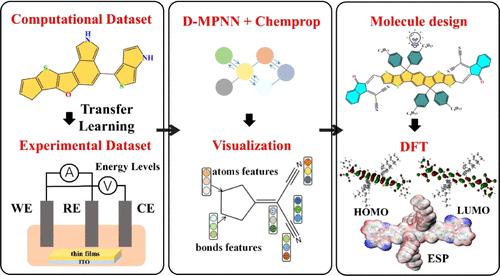当前位置:
X-MOL 学术
›
ACS Appl. Mater. Interfaces
›
论文详情
Our official English website, www.x-mol.net, welcomes your
feedback! (Note: you will need to create a separate account there.)
Combination of Transfer Learning and Chemprop Interpreter with Support of Deep Learning for the Energy Levels of Organic Photovoltaic Materials Prediction and Regulation
ACS Applied Materials & Interfaces ( IF 8.3 ) Pub Date : 2024-11-20 , DOI: 10.1021/acsami.4c15835 Cong Nie, Kuo Wang, Haixin Zhou, Jiahao Deng, Ziye Chen, Kang Zhang, Lingjiao Chen, Di Huang, Jiaojiao Liang, Ling Zhao
ACS Applied Materials & Interfaces ( IF 8.3 ) Pub Date : 2024-11-20 , DOI: 10.1021/acsami.4c15835 Cong Nie, Kuo Wang, Haixin Zhou, Jiahao Deng, Ziye Chen, Kang Zhang, Lingjiao Chen, Di Huang, Jiaojiao Liang, Ling Zhao

|
It is challenging to build a deep learning predictive model using traditional data mining methods due to the scarcity of available data, and the model’s internal decision-making process is often nonintuitive and difficult to explain. In this work, a directed message passing neural network model with transfer learning (TL) and chemprop interpreter is proposed to improve energy levels prediction and visualization for organic photovoltaic materials. The established model shows the best performance, with coefficient of determination reaching 0.787 for HOMO and 0.822 for LUMO in a small testing set after TL, compared to the other four models. Then, the chemprop interpreter analyzes local and global effects of 12 molecular structures on the energy levels for organic materials. After a comprehensive analysis of the energy level effects of nonfullerene Y-series, IT-series, and other organic materials, 12 new IT-series derivatives are designed. 1,1-dicyano-methylene-3-indanone (IC) end group halogenation can reduce HOMO and LUMO energy levels to varying degrees, while IC end group modified by electron-withdrawing aromatic groups can increase HOMO and LUMO energy levels and obtain relatively smaller electrostatic potential (ESP) to reducing intermolecular interactions. The influence of side-chain modification on energy levels is limited. It is worth mentioning that the predicted results of IT-series derivatives match density functional theory calculations. The model also shows good generalization and transferability for predicting the energy levels of other organic electronic materials. This work not only provides a cost-effective model for predicting the energy levels of organic photovoltaic materials but also explains the potential bridge between molecular structure and electronic properties.
中文翻译:

Transfer Learning 和 Chemprop Interpreter 相结合,支持深度学习对有机光伏材料能级的预测和调节
由于可用数据的稀缺性,使用传统的数据挖掘方法构建深度学习预测模型具有挑战性,而且模型的内部决策过程往往不直观且难以解释。在这项工作中,提出了一种具有迁移学习 (TL) 和 chemprop 解释器的定向消息传递神经网络模型,以改进有机光伏材料的能级预测和可视化。与其他四个模型相比,建立的模型显示出最佳性能,在 TL 之后的小测试集中,HOMO 的决定系数达到 0.787,LUMO 的决定系数达到 0.822。然后,chemprop 解释器分析 12 种分子结构对有机材料能级的局部和全局影响。在对非富勒烯 Y 系列、IT 系列和其他有机材料的能级效应进行全面分析后,设计了 12 种新的 IT 系列衍生物。1,1-二氰基-亚甲基-3-茚酮 (IC) 端基卤化可不同程度地降低 HOMO 和 LUMO 能级,而由吸电子芳香族基团修饰的 IC 端基可以提高 HOMO 和 LUMO 能级并获得相对较小的静电电位 (ESP),从而减少分子间相互作用。侧链修饰对能级的影响是有限的。值得一提的是,IT 级数导数的预测结果与密度泛函理论计算相匹配。该模型还显示出良好的泛化性和可转移性,可用于预测其他有机电子材料的能级。 这项工作不仅为预测有机光伏材料的能级提供了一种经济高效的模型,还解释了分子结构和电子特性之间的潜在桥梁。
更新日期:2024-11-20
中文翻译:

Transfer Learning 和 Chemprop Interpreter 相结合,支持深度学习对有机光伏材料能级的预测和调节
由于可用数据的稀缺性,使用传统的数据挖掘方法构建深度学习预测模型具有挑战性,而且模型的内部决策过程往往不直观且难以解释。在这项工作中,提出了一种具有迁移学习 (TL) 和 chemprop 解释器的定向消息传递神经网络模型,以改进有机光伏材料的能级预测和可视化。与其他四个模型相比,建立的模型显示出最佳性能,在 TL 之后的小测试集中,HOMO 的决定系数达到 0.787,LUMO 的决定系数达到 0.822。然后,chemprop 解释器分析 12 种分子结构对有机材料能级的局部和全局影响。在对非富勒烯 Y 系列、IT 系列和其他有机材料的能级效应进行全面分析后,设计了 12 种新的 IT 系列衍生物。1,1-二氰基-亚甲基-3-茚酮 (IC) 端基卤化可不同程度地降低 HOMO 和 LUMO 能级,而由吸电子芳香族基团修饰的 IC 端基可以提高 HOMO 和 LUMO 能级并获得相对较小的静电电位 (ESP),从而减少分子间相互作用。侧链修饰对能级的影响是有限的。值得一提的是,IT 级数导数的预测结果与密度泛函理论计算相匹配。该模型还显示出良好的泛化性和可转移性,可用于预测其他有机电子材料的能级。 这项工作不仅为预测有机光伏材料的能级提供了一种经济高效的模型,还解释了分子结构和电子特性之间的潜在桥梁。


















































 京公网安备 11010802027423号
京公网安备 11010802027423号